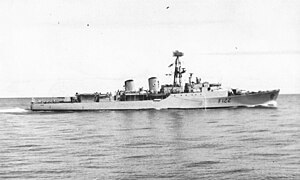 Gurkha circa. 1964-1966
| |
| History | |
|---|---|
| Name | HMS Gurkha |
| Namesake | Gurkha |
| Builder | John I. Thornycroft & Company |
| Laid down | 3 November 1958 |
| Launched | 11 July 1960 |
| Commissioned | 13 February 1963 |
| Decommissioned | 30 March 1984 |
| Identification | Pennant number: F122 |
| Motto |
|
| Fate | Sold to Indonesia 1984 |
| Name | KRI Wilhelmus Zakarias Yohannes |
| Namesake | Wilhelmus Zakaria Johannes |
| Acquired | 1984 |
| Commissioned | 21 October 1985 |
| Stricken | 2000 |
| Identification | Pennant number: 332 |
| Fate | Stricken 2000, scrapped |
| General characteristics | |
| Class and type | Tribal-class frigate |
| Displacement |
|
| Length | |
| Beam | 42 ft 3 in (12.88 m) |
| Draught |
|
| Propulsion |
|
| Speed | 27 knots (50 km/h; 31 mph) (COSAG) |
| Range | 4,500 nautical miles (8,300 km; 5,200 mi) at 12 knots (22 km/h; 14 mph) |
| Complement | 253 |
| Sensors and processing systems | |
| Armament |
|
| Aircraft carried | 1 × Westland Wasp helicopter |
| Service record | |
| Operations: | Third Cod War |
HMS Gurkha (F122) was a Tribal-class frigate of the Royal Navy. She was named after an ethnic group located in Nepal, and who continue to serve in the British Army. She was sold to the Indonesian Navy in 1984 and renamed KRI Wilhelmus Zakarias Yohannes (332).